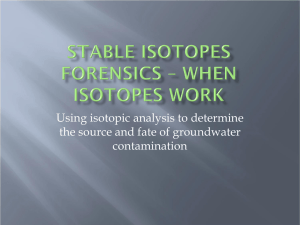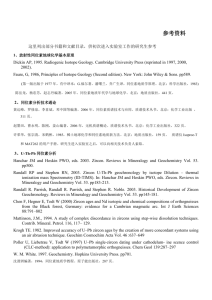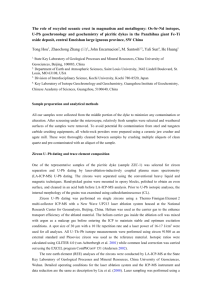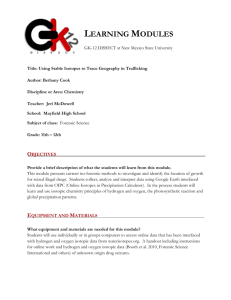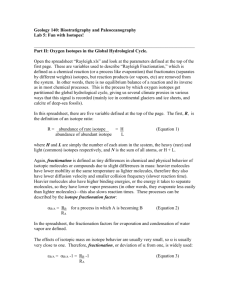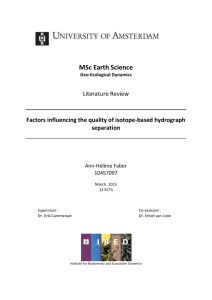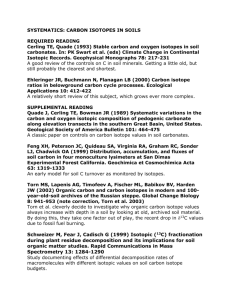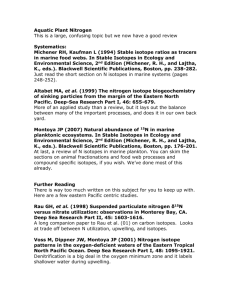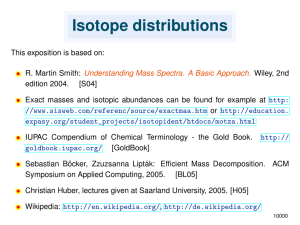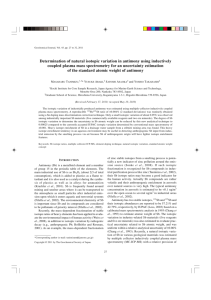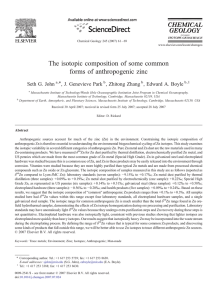G632: BIOGEOCHEMISTRY Isotopic Studies Adlis, D.S., and others
advertisement
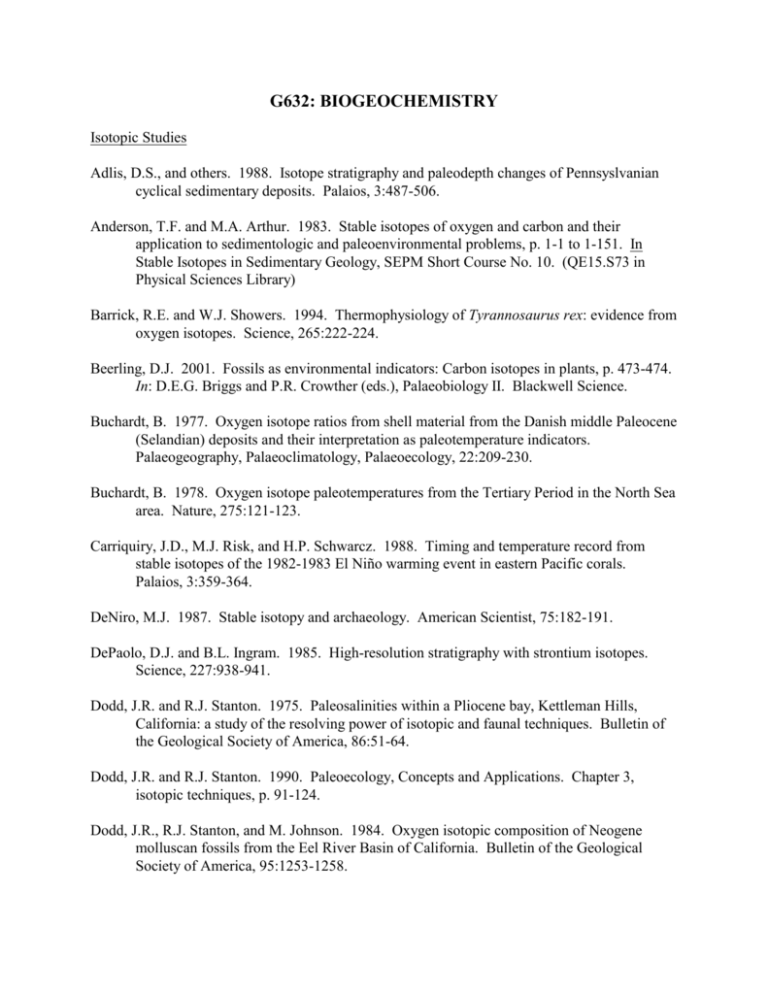
G632: BIOGEOCHEMISTRY Isotopic Studies Adlis, D.S., and others. 1988. Isotope stratigraphy and paleodepth changes of Pennsyslvanian cyclical sedimentary deposits. Palaios, 3:487-506. Anderson, T.F. and M.A. Arthur. 1983. Stable isotopes of oxygen and carbon and their application to sedimentologic and paleoenvironmental problems, p. 1-1 to 1-151. In Stable Isotopes in Sedimentary Geology, SEPM Short Course No. 10. (QE15.S73 in Physical Sciences Library) Barrick, R.E. and W.J. Showers. 1994. Thermophysiology of Tyrannosaurus rex: evidence from oxygen isotopes. Science, 265:222-224. Beerling, D.J. 2001. Fossils as environmental indicators: Carbon isotopes in plants, p. 473-474. In: D.E.G. Briggs and P.R. Crowther (eds.), Palaeobiology II. Blackwell Science. Buchardt, B. 1977. Oxygen isotope ratios from shell material from the Danish middle Paleocene (Selandian) deposits and their interpretation as paleotemperature indicators. Palaeogeography, Palaeoclimatology, Palaeoecology, 22:209-230. Buchardt, B. 1978. Oxygen isotope paleotemperatures from the Tertiary Period in the North Sea area. Nature, 275:121-123. Carriquiry, J.D., M.J. Risk, and H.P. Schwarcz. 1988. Timing and temperature record from stable isotopes of the 1982-1983 El Niño warming event in eastern Pacific corals. Palaios, 3:359-364. DeNiro, M.J. 1987. Stable isotopy and archaeology. American Scientist, 75:182-191. DePaolo, D.J. and B.L. Ingram. 1985. High-resolution stratigraphy with strontium isotopes. Science, 227:938-941. Dodd, J.R. and R.J. Stanton. 1975. Paleosalinities within a Pliocene bay, Kettleman Hills, California: a study of the resolving power of isotopic and faunal techniques. Bulletin of the Geological Society of America, 86:51-64. Dodd, J.R. and R.J. Stanton. 1990. Paleoecology, Concepts and Applications. Chapter 3, isotopic techniques, p. 91-124. Dodd, J.R., R.J. Stanton, and M. Johnson. 1984. Oxygen isotopic composition of Neogene molluscan fossils from the Eel River Basin of California. Bulletin of the Geological Society of America, 95:1253-1258. Douglas, R.G. and S.M. Savin. 1978. Oxygen isotopic evidence for the depth stratification of Tertiary and Cretaceous planktic foraminifera. Marine Micropaleontology, 3:175-196. Goodwin, D.H., et al. 2001. Cross-calibration of daily growth increments, stable isotope variation, and temperature in the Gulf of California bivalve mollusk Chione cortezi: implications for paleoenvironmental analysis. Palaios, 16:387-398. Grossman, E.L., H. Mii, T.E. Yancey. 1993. Stable isotopes in Late Pennsylvanian brachiopods from the United States: implications for Carboniferous paleoceanography. Geological Society of America Bulletin, 105: 1284-1296. Ingram, B.L. and D. Sloan. 1992. Strontium isotopic composition of estuarine sediments as paleosalinity-paleoclimate indicator. Science, 255: 68-72. Ivany, L.C. and R.J. Salawitch. 1993. Carbon isotopic evidence for biomass burning at the K-T boundary. Geology, 21: 487-490. Joyce, J.E., L.R.C. Tjalsma, and J.M. Prutzman. 1993. North American glacial meltwater history for the past 2.3 m.y.: oxygen isotope evidence from the Gulf of Mexico. Geology, 21: 483-486. Juillet-Leclerc, A. and H. Schrader. 1987. Variations of upwelling intensity recorded in varved sediments from the Gulf of California during the past 3,000 years. Nature, 329:146-149. Kammer, T.W. 1979. Paleosalinity, paleotemperature, and isotopic fractionation records of Neogene foraminifera from DSDP site 173 and the Centerville Beach section, California. Marine Micropaleontology, 4:45-60. Kennett, J.P. and N.J. Shackleton. 1975. Laurentide ice sheet meltwater recorded in Gulf of Mexico deep-water cores. Science, 188:147-150. Magaritz, M. 1989. C13 minima follow extinction events: a clue to faunal radiation. Geology, 17:337-340. Mii, H.-S. and E.L. Grossman. 1994. Late Pennsylvanian seasonality reflected in the 18 O and elemental composition of a brachiopod shell. Geology, 22:661-664. Mix, A.C. and N.G. Pisias. 1988. Oxygen isotope analyses and deep-sea temperature changes: implications for rates of oceanic mixing. Nature, 331:249-251. Murphy, A.E., B.B. Sageman, and D.J. Hollander. 2000. Eutrophication by decoupling of the marine biogeochemical cycles of C, N, and P: a mechanism for the Late Devonian mass extinction. Geology, 28:427-430. Ostrom, P.H., S.A. Macko, M.H. Engel, and D.A. Russell. 1993. Assessment of trophic structure of Cretaceous communities based on stable nitrogen isotope analyses. Geology, 21: 491-494. Popp, B.N., F.A. Podosek, J.C. Brannon, T.F. Anderson, and J. Pier. 1986. 87Sr/86Sr ratios in Permo-Carboniferous sea water from the analyses of well-preserved brachiopod shells. Geochimica et Cosmochimica Acta, 50: 1321-1328. Sælen, G., P. Doyle, and M.R. Talbot. 1996. Stable-isotope analysis of belemnite rostra from the Whitby Mudstone Fm., England: Surface water conditions during deposition of a marine black shale. Palaios, 11:97-117. Saraswati, P.K., R. Ramesh, and S.V. Navada. 1993. Paleogene isotopic temperatures of western India. Lethaia, 26: 89-98. Savin, S.M. 1982. Stable isotopes in climatic reconstructions, p. 164-171. In Climate in Earth History, National Academy Press. Savin, S.M., R.G. Douglas, and F.G. Stehli. 1975. Tertiary marine paleotemperatures. Bulletin of the Geological Society of America, 86:1499-1510. Schidlowski, M. 1988. A 3800-million-year isotopic record of life from carbon in sedimentary rocks. Nature, 333:313-318. Shackleton, N.J. and J.P. Kennett. 1975. Paleotemperature history of the Cenozoic and the initiation of Antarctic glaciation: oxygen and carbon isotope analysis in DSDP sites 277, 279, and 281. In J.P. Kennett et al., Initial Reports of the Deep Sea Drilling Project, 29:743-755. Surge, D., K.C. Lohmann, and D.L. Dettman. 2001. Controls on isotopic chemistry of the American oyster, Crassostrea virginica: implications for growth patterns. Palaeogeography, Palaeoclimatology, Palaeoecology, 172:283-296. PDF Tan, F.C. and J.D. Hudson. 1974. Isotopic studies of the paleoecology and diagenesis of the Great Estuarine Series (Jurassic) of Scotland. Scottish Journal of Geology, 10:91-128. Urey, H.C., H.A. Lowenstam, S. Epstein, and C.R. McKinney. 1951. Measurements of paleotemperatures and temperatures of the Upper Cretaceous of England, Denmark, and the southeastern United States. Bulletin of the Geological Society of America, 62:399416. The classic paper on oxygen isotopes. Wang, K., H.H.J. Geldsetzer, and H.R. Krouse. 1994. Permian-Triassic extinction: organic M13C evidence from British Columbia, Canada. Geology, 22:580-584. Trace Chemistry Dodd, J.R. 1964. Environmentally controlled variation in the shell structure of a pelecypod species. Journal of Paleontology, 38:1065-1071. Dodd, J.R. and T.J.M. Schopf. 1972. Approaches to biogeochemistry, p. 46-60. In T.J.M. Schopf (ed.), Models in Paleobiology. Dodd, J.R. and R.J. Stanton. 1990. Paleoecology, Concepts and Applications. Chapter 3, trace chemistry, p. 83-91. Stanton, R.J. and J.R. Dodd. 1970. Paleoecologic techniques: comparison of faunal and geochemical analyses of Pliocene paleoenvironments, Kettleman Hills, California. Journal of Paleontology, 44:1092-1121.
